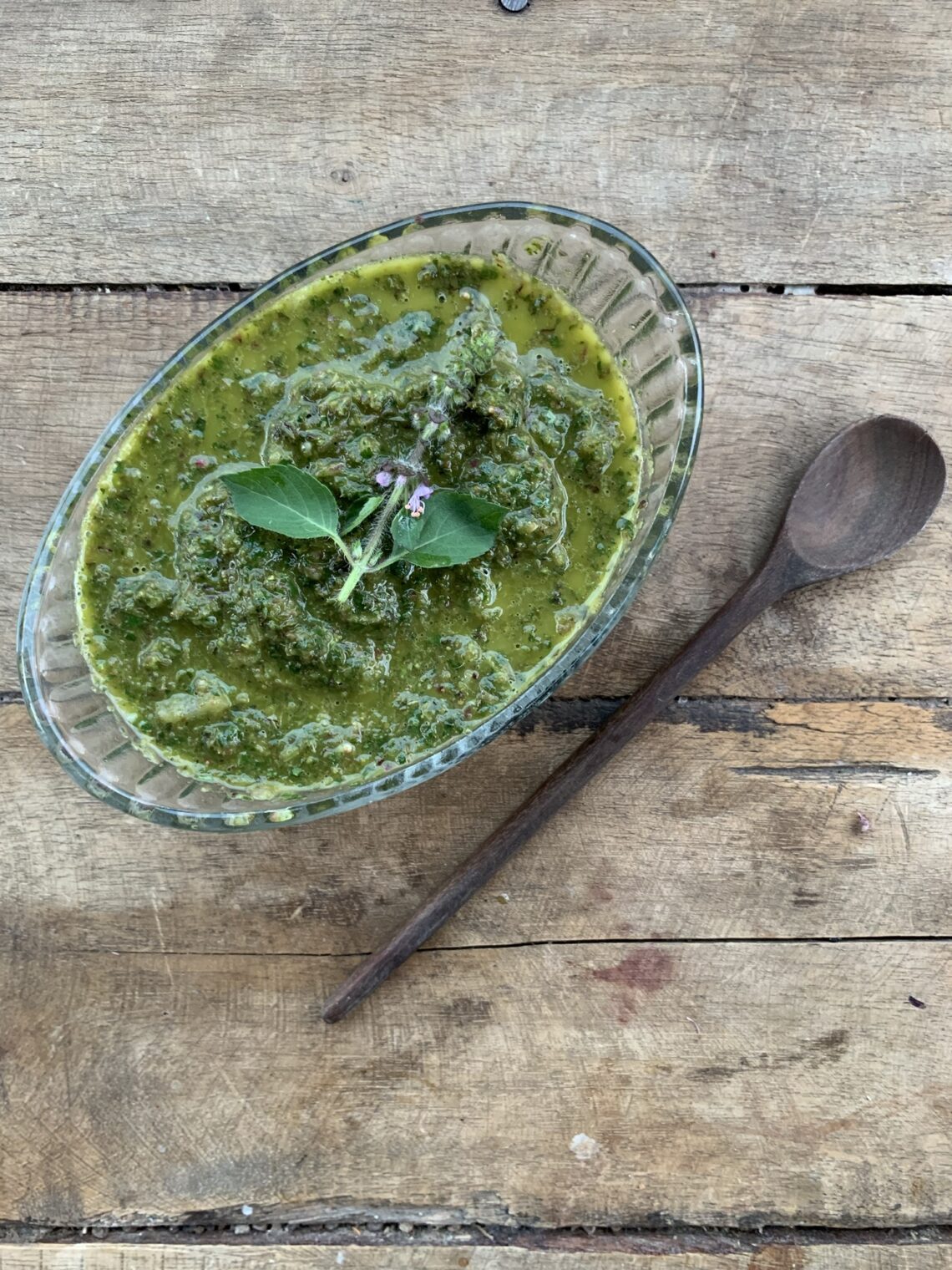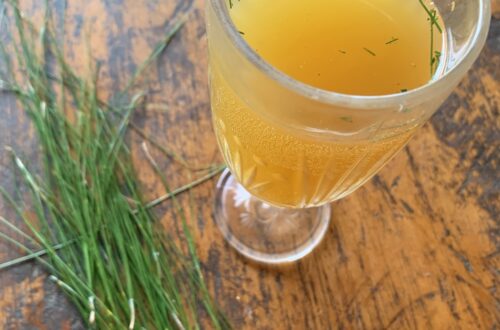Last Updated on October 26, 2025
Cherished for its calming, adaptogenic properties, tulsi is a beloved ally in herbal traditions around the world. But despite its bold aroma and unique flavor, tulsi under appreciated as a culinary herb. Fresh tulsi tastes slightly sweet and peppery, with notes of clove and anise, and it can add depth of flavor to a variety of drinks, condiments, and dishes.
Tulsi Chimichurri is one of my favorite ways to showcase tulsi’s unique flavor profile. It’s super tasty and perfect for sprucing up eggs, roasted vegetables, grilled meats, salads, and so much more! My family also loves slathering it on quesadillas or arepas. This vibrant sauce is a fresh twist on traditional Argentinian chimichurri, an herbal condiment typically made with parsley, oregano, garlic, red wine vinegar, and olive oil, that is usually served with grilled meats.
Health Benefits of Tulsi
Tulsi has long been revered in Ayurvedic medicine for its ability to treat a variety of health conditions. Historically used for skin issues, fevers, insect and snake bites, malaria, asthma, bronchitis, diabetes, diarrhea, and eye ailments, many of its traditional uses are now backed by modern science. Here are some of the beneficial properties of tulsi.
Rich in Nutrients
There are several varieties of tulsi, each with slightly different nutrient profiles, but tulsi in general contains a wide range of important vitamins and minerals. It’s an excellent source of vitamins A, C, and K, as well as iron, copper, and manganese, which support immune function, circulation, and antioxidant activity. Tulsi also provides a good amount of folate, magnesium, potassium, and B vitamins (Yadava et al., 2024) Even in small doses, this herb is a nourishing addition to drinks, condiments, and dishes.
Boosts Detoxification and Digestive Health
Tulsi is a powerful antioxidant that helps the body detoxify by neutralizing harmful pollutants and free radicals. It also supports healthy metabolism and improves nutrient absorption, making it a gentle aid for digestion. Additionally, studies have shown that tulsi has significant antiulcer and anti-inflammatory properties, helping to protect the stomach lining from irritants and support digestive health (Singh & Majumdar, 1999; Yadava et al., 2024)
Supports Metabolic Health
Research shows that taking tulsi leaf extracts or powders can help lower fasting blood sugar and improve how the body manages glucose, making it a helpful ally for those with type 2 diabetes or other metabolic issues. It also supports healthy cholesterol and blood pressure, contributing overall metabolic health (Jamshidi & Cohen, 2017).
Regulates Immune Response
Tulsi may help to give the immune system a boost by increasing the activity of Natural Killer (NK) and T-helper cells, which help the body fight infections. Studies have found that taking tulsi improves immune response to viral infection, including the herpes virus and SARS-CoV-2 (Jamshidi & Cohen, 2017; Upadhyay et al., 2022).
Improves Mood and Cognitive Function
Tulsi has been shown to support mental clarity and emotional well-being. Research suggests it can improve memory, focus, and cognitive function, while also helping to reduce stress and anxiety, especially when taken consistently over time. Its calming, adaptogenic properties make it a helpful ally for supporting mood and mental capacity.
Adding fresh tulsi to your meals, like in this chimichurri recipe, is a tasty way to enjoy its unique flavor and welcome some of its health benefits.
What You Need to Make Tulsi Chimichurri
- Apple cider vinegar
- Red onion
- Fresh tulsi leaves
- Olive oil
- Salt
- Lime juice
- Black pepper
How to Make Tulsi Chimichurri
To make tulsi chimichurri, start by soaking thinly sliced red onions in apple cider vinegar. This step mellows out their flavor a bit. While the onion are soaking, pulse fresh tulsi leaves in a food processor until they’re finely chopped.
Next, add the soaked onions along with their vinegar to the processor and blend until combined, keeping a bit of texture. Then, add olive oil, lime juice, salt, and pepper, blending just enough to bring the sauce together. The result is a fresh, herbaceous sauce with tulsi’s unique sweet and peppery notes.
Let the chimichurri rest for at least 30 minutes before serving to allow the flavors to meld. Store it in the fridge and enjoy within about five days.
How to Use Tulsi Chimichurri
Tulsi chimichurri is flavorful, bright, and surprisingly versatile. Spoon it over roasted vegetables, drizzle it on eggs, or use it as a spread on sandwiches and wraps. It also makes a delicious marinade for chicken. Stir a spoonful into soups or stews for a pop of flavor, or whip it into a quick salad dressing. However you use it, this herb-bases condiment adds an tasty, uplifting twist to to whatever you put it on.
Marinating with Tulsi Chimichurri
This chimichurri can be used as a delicious marinade. To use it this way, coat your protein and let it sit for at least 30 minutes (or up to a few hours) before cooking. The vinegar helps tenderize and the tulsi lends depth of flavor.
Tulsi Chimichurri Salad Dressing
For a quick, herby salad dressing, simply whisk your chimichurri with a little extra olive oil and vinegar (or lemon juice) to thin it out. The tulsi adds a slightly peppery, refreshing kick that plays beautifully with fresh greens.
Ingredients
Method
- Slice the red onion thinly and place in a small, shallow dish. Cover with vinegar and let sit for 10 minutes to help mellow the flavor of the onion.
- Add the fresh tulsi leaves to a food processor and pulse until the leaves are finely chopped.
- Add the soaked red onion and vinegar and pulse again until well incorporated.
- Add the remaining ingredients and blend until smooth.
- Taste and adjust salt, vinegar, or spice as needed.
- Transfer to a jar and let it sit for at least 30 minutes before serving to allow the flavors to meld.
- Store in the refrigerator and use within about 5 days.
References
Jamshidi, N., & Cohen, M. M. (2017). The Clinical Efficacy and Safety of Tulsi in Humans: A Systematic Review of the Literature. Evidence-based complementary and alternative medicine : eCAM, 2017, 9217567. https://doi.org/10.1155/2017/9217567
Singh, S., & Majumdar, D. K. (1999). Evaluation of the gastric antiulcer activity of fixed oil of Ocimum sanctum (Holy Basil). Journal of Ethnopharmacology, 65(1), 13–19. https://doi.org/10.1016/S0378-8741(98)00142-1
Upadhyay, S., Yadav, D., Singh, M., Yadav, M., Upadhyay, K., & Singh, R. (2022, March 15). Ayurvedic approach of some indigenous flora in curbing SARS-CoV-2 infection: II. Traditional medicinal plants for strengthening of immune system and treatment of COVID-19. International Journal of Botany Studies, 7, 72–78.
Yadava, S. P., Pathaka, P., Kanaujia, A., Das, A., Saxena, M. J., & Kalra, A. (2024). Health and therapeutic uses of tulsi (holy basil). Octa Journal of Environmental Research, 12(1), 4–15.





